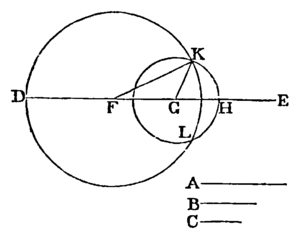PROPOSITION 22. PROBLEM.
To make a triangle of which the sides shall be equal to three given straight lines, but any two whatever of these must be greater than the third.
Let A, B, C be the three given straight lines, of which any two whatever are greater than the third; namely, A and B greater than C; A and C greater than B; and B and C greater than A: it is required to make a triangle of which the sides shall be equal to A, B, C, each to each.

Take a straight line DE terminated at the point D, but unlimited towards E, and make DF equal to A, FG equal to B, and GH equal to C. [I. 3.
From the centre F, at the distance FD, describe the circle DKL. [Post. 3.
From the centre G, at the distance GH, describe the circle HLK, cutting the former circle at K.
Join KF, KG. The triangle KFG shall have its sides equal to the three straight lines A,B, C.
Because the point F is the centre of the circle DKL, FD is equal to FK. [Definition 15.
But FD is equal to A. [Construction.
Therefore FK is equal to A. [Axiom 1.
Again, because the point G is the centre of the circle HLK, GH is equal to GK [Definition 15.
But GH is equal to C. [Construction.
Therefore GK is equal to C. [Axiom 1.
And FG is equal to B. [Construction.
Therefore the three straight lines KF, FG, GK are equal to the three A, B, C.
Wherefore the triangle KFG has its three sides KF, FG, GK equal to the three given straight lines A, B, C. q.e.f.
